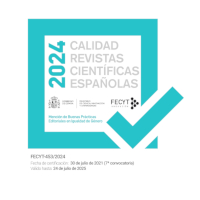Las novelas intercaladas de Cervantes en The Comical History of Don Quixote
DOI:
https://doi.org/10.18172/cif.3017Palabras clave:
Don Quijote, Cervantes, Thomas D’Urfey, The Comical History of Don Quixote, novelas intercaladas, teatro de la RestauraciónResumen
Inmensamente populares en la Gran Bretaña del siglo XVII, los episodios intercalados de Marcela y Cardenio aparecieron en la representación de la primera adaptación teatral británica de la obra maestra de Cervantes: The Comical History of Don Quixote, de Thomas D’Urfey. Este artículo proporciona un análisis comparativo de las mencionadas historias en ambas obras. El análisis de la novela cervantina revela que los protagonistas de estos cuentos encarnan una identidad contrahegemónica que subvierte las nociones dominantes de género y clase. Por tanto, la obra de D’Urfey se aborda con el objetivo de determinar si se conserva el potencial subversivo del original. Puede afirmarse que, al contrario de su predecesor literario, D’Urfey explota estos episodios para reforzar y naturalizar la ideología hegemónica y el orden social resultante.
Descargas
Citas
ANDERSON, C. L. (1988). “Cardenio’s Tale in the Quijote: Cervantes’s Psycho-drama”. Hispanófila 32 (1): 21-33.
BANDERA, C. (1975). Mímesis Conflictiva: Ficción Literaria y Violencia en Cervantes y Calderón. Madrid: Gredos.
BURTON, R. 2009 (1638). The Anatomy of Melancholy: What it is, with All the Kinds, Causes, Symptoms, Prognostics, and Several Cures of It. In Three Partitions; With Their Several Sections, Members, and Subsections, Philosophically, Medically, Historically Opened and Cut Up. Ex-classics project. <http://www.gutenberg.org/ebooks/10800> [Access 22 January 2014].
CERVANTES, M. (1894). El ingenioso hidalgo don Quijote de la Mancha. Comentado por Diego Clemencín, vol. I. Madrid: Librería de la Viuda de Hernando y C.
CERVANTES, M. (2009). Don Quijote de La Mancha. (Ed. Francisco Rico). Madrid: Punto de Lectura.
D’URFEY, T. (1729): The Comical History of Don Quixote. London: Printed for J. Darby, A. Bettesworth, and F. Clay.
DUDLEY, E. (1972). “The Wild Man Goes Baroque” in The Wild Man Within: An Image in Western Thought from the Renaissance to Romanticism. (Eds. E. Dudley and M.E. Novak). Pittsburgh: University of Pittsburgh Press. DOI: https://doi.org/10.2307/jj.5590584
FAJARDO, S. J. (2005). “Narración e identidad: el caso de Cardenio” in Cervantes y su mundo Vol. II. (Eds. K Reichenberger and Fernández-Morera). Kassel: Reichenberg.
FEAL, C. (1993). “Against the Law: Mad Lovers in Don Quixote” in Quixotic Desire: Psychoanalytic Perspectives on Cervantes. (Eds. R.S. El Saffar and D. de Armas). Ithaca: Cornell University Press.
FINELLO, D. L. (1986). “Shepherds at Play: Literary Conventions and Disguises in the Pastoral Narratives of the Quijote.” In Cervantes and the Pastoral. (Eds. J. Labrador amd J. Fernández). Cleveland: Cleveland State University.
FLETCHER, A. (1995). Gender, Sex and Subordination in England 1500-1800. New Haven: Yale University Press.
FUCHS, B. (2003). Passing for Spain: Cervantes and the Fictions of Identity. Illinois: University of Illinois Press.
GÓMEZ-LARA, M. J. et al. (2014). The Marriage Hater: A Comedy by Thomas Durfey. Barcelona: Edicions Universitat Barcelona.
GONZÁLEZ-ECHEVARRÍA, R. (2005). Love and the Law in Cervantes. New Haven: Yale University Press.
HATHAWAY, R. L. (1999). “Cardenio’s Twice-Told Tale”. Cervantes: Bulletin of the Cervantes Society of America 19 (1): 4-26. DOI: https://doi.org/10.3138/Cervantes.19.1.004
HERNÁNDEZ-PECORARO, R. (1998). “The Absence of the Absence of Women: Cervantes’s Don Quixote and the Explosion of the Pastoral Tradition”. Cervantes: Bulletin of the Cervantes Society of America 18 (1): 24-45. DOI: https://doi.org/10.3138/cervantes.18.1.024
HERRERO, J. (1978). “Arcadia’s Inferno: Cervantes’ Attack on Pastoral”. Bulletin of Hispanic Studies 55: 289-99. DOI: https://doi.org/10.1080/1475382782000355289
HOWE, E. (1994). The First English Actresses: Women and Drama 1660-1700. Cambridge: Cambridge University Press.
JEHENSON, M. Y. (1990). “The Pastoral Episode in Cervantes’ Don Quijote: Marcela Once Again”. Cervantes: Bulletin of the Cervantes Society of America 10 (2): 15-35. DOI: https://doi.org/10.3138/cervantes.10.2.015
LAFFEY, L. A. (1997). “Marcella and the Chivalric Tradition: The Free Spirit Who Refuses to Be Inscribed”. Romance Languages Annual 9: 550-554.
LAQUEUR, T. (1987). “Orgasm, Generation, and the Politics of Reproductive Biology” in The Making of the Modern Body: Sexuality and Society in the Nineteenth Century. (Eds. T. Laqueur and C. Gallagher). Berkeley: University of California Press.
LEHFELDT, E. (2008). “Ideal Men: Masculinity and Decline I Seventeenth-Century Spain”. Renaissance Quarterly 61 (2): 463-494. DOI: https://doi.org/10.1353/ren.0.0024
MACKIE, E. (2009). Rakes, Highwaymen, and Pirates: The Making of the Modern Gentleman in the Eighteenth Century. Baltimore: The Johns Hopkins University Press.
MADARIAGA, S. (1978. Guía del lector del Quijote. Madrid: Espasa Calpe.
MÁRQUEZ-VILLANUEVA, M. (2011). Personajes y temas del Quijote. Barcelona: Ediciones Bellaterra.
MCCALLISTER, T. (2011). “Intercalated Grace at Juan Palomeque’s Inn”. Cervantes: Bulletin of the Cervantes Society of America 31 (1): 109-133. DOI: https://doi.org/10.1353/cer.2011.0006
MCGAHA, M. D. (1977). “The Sources and Meaning of the Grisóstomo-Marcela Episode in the 1605 Quijote”. Anales cervantinos 16: 33-69.
MCKENDRICK, M. (1983). “Women Against Wedlock: The Reluctant Brides of Golden Age Drama” in Women in Hispanic Literature: Icons and Fallen Idols. (Ed. B. Miller). Bekerley: University of California Press: 115-146. DOI: https://doi.org/10.1525/9780520378889-008
NAVARRO, E. (1993). “Manual Control: ‘Regulatory Fictions’ and their Discontents”. Cervantes: Bulletin of the Cervantes Society of America 13 (2): 17-35. DOI: https://doi.org/10.3138/cervantes.13.2.017
NUSSBAUM, F. A. (1984). The Brink of All We Hate: English Satires on Women 1660-1750. Kentucky: The University Press of Kentucky.
PERCAS DE PONSETI, H. (1999). “Luscinda y Cardenio: Autenticidad psíquica frente a inverosimilitud novelísitca” in Ingeniosa Invención: Essays on Golden Age Spanish Literature for Geoffrey L. Stagg in Honor of His Eightyfifth Birthday. (Eds. E.M. Anderson and A.R. Williamsen). Delaware: Juan de la Cuesta
POGGLIOLI, R. (1975). The Oaten Flute: Essays on Pastoral Poetry and the Pastoral Ideal. Cambridge: Harvard University Press. DOI: https://doi.org/10.4159/harvard.9780674421585
RODRÍGUEZ-LUIS, J. (1976). “Los dos comienzos de la historia de Cardenio”. Nueva Revista de Filología Hispánica 25: 102-11. DOI: https://doi.org/10.24201/nrfh.v25i1.2789
SIEBER, H. (1974). “Society and the Pastoral Vision in the Marcela-Grisóstomo Episode of Don Quijote” in Estudios literarios de hispanistas norteamericanos dedicados a Helmut Hatzfeld con motivo de su ochenta aniversario. (Eds. J.M. Solà-Solé et al.). Barcelona: Hispam.
TRUMBACH, R. (1987). “Sodomitical Subcultures, Sodomitical Roles, and the Gender Revolution of the Eighteenth Century: The Recent Historiography” in ‘Tis Nature’s Fault: Unauthorized Sexuality During the Enlightenment. (Ed. R.P. Maccubbin). New York: Cambridge University Press. DOI: https://doi.org/10.1017/CBO9780511629488.010
VALLEJO-NÁGERA, A. (1950). Literatura y psiquiatría. Barcelona: Barna.
VÉLEZ-NÚÑEZ, R. (2003). “Melancholic sounds: singing madness in Restoration Drama”. Sederi. 13: 219-227.
VÉLEZ-SAINZ, J. (2005). “Un basilisco sans mercy: Marcela y la tradición misógina medieval” en Los personajes femeninos en El Quijote. (Ed. F. Rubio). Madrid: Ayuntamiento de Madrid.
VOLLENDORF, L. (2005). “Cervantes and His Women Readers”. Romance Quarterly 52 (4): 312-327. DOI: https://doi.org/10.3200/RQTR.52.4.312-327
WINKLER, A. E. (2006). O Let Us Howle Some Heavy Note: Music for Witches, the Melancholic, and the Mad on the Seventeenth-century English Stage. Bloomington: Indiana University Press. DOI: https://doi.org/10.2307/j.ctt2005sqt
Descargas
Publicado
Cómo citar
Número
Sección
Licencia
El autor o autora conserva todos los derechos sobre su artículo y cede a la revista el derecho de la primera publicación, no siendo necesaria la autorización de la revista para su difusión una vez publicado. Una vez publicada la versión del editor el autor está obligado a hacer referencia a ella en las versiones archivadas en los repositorios personales o institucionales.
El artículo se publicará con una licencia Creative Commons de Atribución, que permite a terceros utilizar lo publicado siempre que se mencione la autoría del trabajo y la primera publicación en esta revista.
Se recomienda a los autores/as el archivo de la versión de editor en repositorios institucionales.














